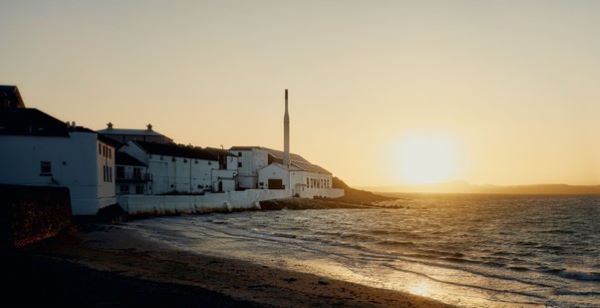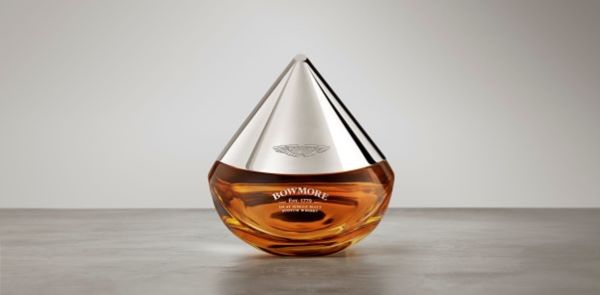BOWMORE – Behind the Label
Islay's oldest distillery is relatively boutique compared to its big rivals discovers Tom Bruce-Gardyne. But now, with a powerful Aston Martin engine under its bonnet, Bowmore is keen to raise its profile and make more noise …
Unlike most malt distilleries, the pagoda roofs at Bowmore on Islay are no mere ornament. They have stayed true to their original function of drawing the peat smoke up from the kiln through the grain and out into the air. While they don't entirely satisfy Bowmore's needs, they make a hefty contribution.
"About 25% of all the malted barley used comes from our own floor maltings, that we turn by hand every four to six hours over the course of five to seven days," explains the brand's global marketing director, Kirsteen Beeston. As laborious and antiquated as it sounds, the process underscores the craftmanship involved, and seeing it all in action and smelling the bittersweet smoke wafting outside enhances the visitor experience no end.

"Someone once described the process of creating Bowmore as the seven steps to heaven, and I really like that," she says, and well, she might, for it's a nice quote to bandy around, to tweet and retweet. For her, it reflects how "there is such care that goes into each and every stage to ensure that what comes out at the end is something full of flavour and character."
What comes out is not a lot. According to the IWSR, Bowmore sells just 150,000 cases a year compared to the market leaders – The Glenlivet and Glenfiddich which are both on over a million cases. Other well-known brands like The Macallan, Glenmorangie and The Singleton are also much bigger, but of course, none of them malt their own barley, which is clearly a limiting factor.
"If we wanted to scale up production, we would need to scale up our floor maltings first before we could even talk about additional stills," says Kirsteen, who believes Bowmore's relatively compact size is more of a blessing than a curse. For one thing it allows the brand to be selective in where it sells.
"Bowmore's centre of gravity over the last 5 – 10 years has been in Asia and travel retail," she says, which challenges the stereotype mentioned by Glenmorangie's CEO, Caspar MacRae, of malt drinkers being ‘middle-aged, white, Western and male'. "That's not what we see in China or Singapore," she retorts. "We see females and younger drinkers."
After duty-free, the brand's biggest market, comes Japan, where some 20,000 cases a year are sold, which is perhaps not surprising, being part of Suntory since 1994. Next is China on about 15,000 cases, followed by Canada on 11,000, and the UK and Germany on around 7,000 cases apiece.

Taiwan looks like a missed opportunity, though apparently, Suntory chose Auchentoshan to be its single malt flagbearer in the region for reasons that are not entirely obvious. Being underexposed in America may be a good thing, however, with Diageo reporting a 27% slump in net sales of its malts in the region in the second half of last year (HY24)
"I think it's tough for everyone right now," says Kirsteen. "There are very few single malt brands that are in growth, and the category, overall, is not having a good time." That said, in a country like China, where "our market share is so small, we've still got headroom to grow," she says.
Bowmore is determined to punch above its weight, and she believes that "the size and scale of the brand shouldn't correlate to the size and scale of the marketing, necessarily." On which note, Bowmore scored a major coup when it climbed into bed with Aston Martin in 2019. Rumour has it there were quite a few single malts sniffing around to make a deal with the car made famous by 007 fifty years ago.
"Where's my Bentley?" Bond demands to know in Goldfinger (1964). "Oh, it's had its day, I'm afraid," replies Q, who then unveils the legendary Aston Martin DB5 in battleship grey, complete with machine guns and an ejector seat. The car has reappeared in many Bond movies since.
The Macallan, which secured a starring role in the film Skyfall for an undisclosed sum in 2012, quickly followed Bowmore's lead and partnered up with Bentley in 2021. Cue wry smiles at Suntory – imitation being the sincerest form of flattery. For Kirsteen, the tie-up with Aston Martin "gives us broader cultural relevance, and I think it gives us access to consumers who may not have considered Bowmore in the past."
"It does it through the innovation products we create hand in hand with Aston, which span a full spectrum, with ARC at the very top-end," she says, referring to the 52-year-old release in extremely fancy packaging at £67,500. At the other end are Bowmore's travel retail special editions, starting with a 10-year-old at under £100, and therefore "infinitely more accessible".

She talks of her brand having "many assets in its jewellery box" besides its island home and says: "If we were to rely solely on Islay to sell Bowmore, we would seriously be missing a trick." It may be the oldest surviving distillery here, with roots stretching back to 1779, but the focus on provenance is left to its famously smoky stablemate, Laphroaig. "I think Laphroaig is the story of ‘iconic Islay', and that's how we distinguish the two brands," she says.
Bowmore naturally plays on scarcity for its high-end expressions released in small batches, but "that rarity also lives within our core range, and I don't think that's necessarily well-understood," says Kirsteen. The distillery is not tiny, but with a capacity of 2m lpa it is dwarfed by The Macallan on around 15m and The Glenlivet on over 20m.
"That is one of the reasons we are embarking on a more broad branch transformation which will see us reshape the look and aesthetic of Bowmore," she says. The packaging is being worked on behind the scenes, and a new oak cask range will be released later this year. She is hoping these small steps and others will lead to a place "where we're no longer hiding our light under a bushel."

Award-winning drinks columnist and author Tom Bruce-Gardyne began his career in the wine trade, managing exports for a major Sicilian producer. Now freelance for 20 years, Tom has been a weekly columnist for The Herald and his books include The Scotch Whisky Book and most recently Scotch Whisky Treasures.
You can read more comment and analysis on the Scotch whisky industry by clicking on Whisky News.




